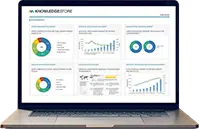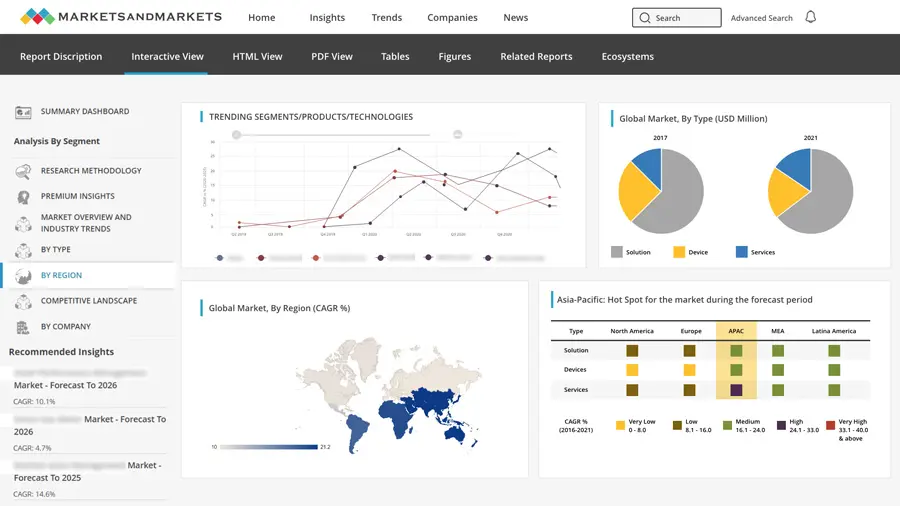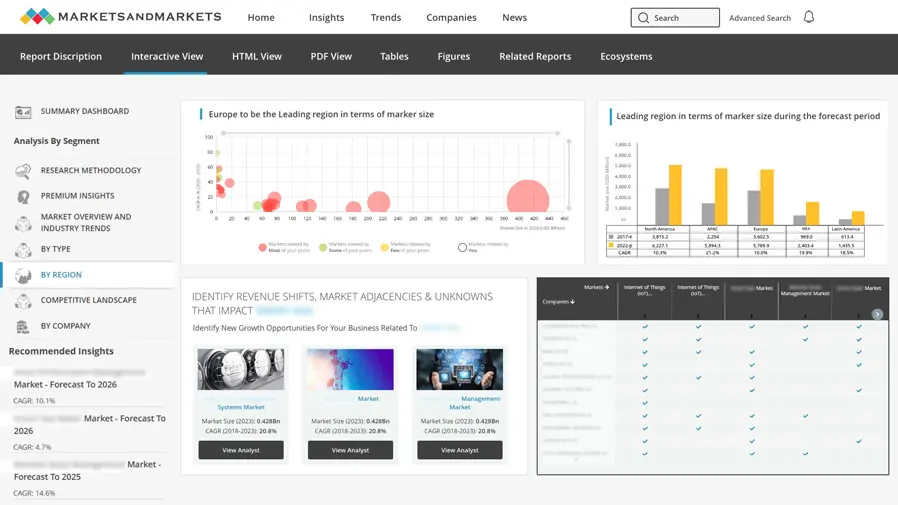Space Traffic Management Market by Technology (AI, IoT, Radar, Collision Avoidance Systems), Offering (Hardware, Software, Services), Application (Satellite Operations, Space Debris Management, Orbital Traffic Coordination), End-Use Industry (Government, Commercial, Defense), and Region – Global Forecast to 2030
Overview
The space traffic management market is emerging as a critical component in the growing space economy. As the number of satellites, space debris, and other space-based activities continue to proliferate, effective space traffic management (STM) has become essential to ensure the safety and sustainability of space operations. Space traffic management involves monitoring, controlling, and mitigating risks associated with satellite and debris collisions, coordination between operators, and regulation of space activities to avoid congestion and ensure efficient and safe use of orbital spaces.
The rising interest in space exploration, satellite-based services (such as communications, weather monitoring, and GPS), and the increasing deployment of mega constellations by companies like SpaceX and OneWeb have made space traffic management a necessity. The market is poised to grow rapidly as governments, private companies, and international organizations recognize the importance of avoiding space debris collisions and maintaining a secure space environment for future missions.
Attractive Opportunities
Several attractive opportunities are emerging in the space traffic management market due to its growing importance. These include:
- Regulatory Developments and Standardization: As space traffic management becomes an essential aspect of space exploration, regulatory frameworks will evolve, offering growth prospects for companies involved in STM services. Standardization of operational procedures to mitigate space debris and manage satellite trajectories is expected to open new business avenues.
- Advancements in AI and Automation: Artificial Intelligence (AI) and automation technologies are being integrated into space traffic management to monitor and predict space objects, manage satellite orbit adjustments, and reduce human intervention in space operations. Companies focusing on these technologies will find significant opportunities in STM systems.
- Commercial Satellite Launches: The increase in satellite launches and the growing trend of low Earth orbit (LEO) constellations presents an opportunity to offer STM solutions for commercial operators. Providers of satellite collision avoidance systems and space traffic management software will see rising demand.
- Partnerships and Collaborations: Strategic partnerships between space agencies, private space companies, and academic institutions could accelerate STM innovation. Collaborations could focus on improving data-sharing protocols, tracking systems, and enhancing the regulatory environment for better management of space traffic.
- De-orbiting Technologies: Another growing opportunity lies in the development of technologies aimed at removing defunct satellites and debris from space. Companies that focus on developing and deploying effective de-orbiting solutions could play a significant role in space traffic management.
Global Market Dynamics
-
Market Drivers
- Increasing Space Activity: The number of satellites launched annually has grown significantly, driven by commercial interests, government missions, and national security concerns. The rapid expansion of satellite constellations for global internet coverage, such as SpaceX's Starlink, is contributing to this increase in space traffic.
- Space Debris Concerns: Space debris is a significant concern due to its risk of colliding with operational satellites and spacecraft. As space activity increases, so does the potential for debris creation, which in turn fuels the demand for STM solutions to avoid collisions and manage orbital space effectively.
- Government Initiatives: Governments and space agencies are increasingly recognizing the need for regulatory frameworks to manage space traffic and debris. Initiatives such as the United Nations' long-term sustainability guidelines for space activities and national space policies promote the need for effective space traffic management solutions.
-
Market Restraints
- High Cost of STM Systems: Implementing advanced STM solutions can be costly, especially for smaller players or organizations with limited budgets. High upfront investments in tracking systems, debris mitigation technologies, and regulatory compliance measures may limit the widespread adoption of STM solutions.
- Lack of Global Coordination: While some countries have made strides in space traffic management, there is no unified global regulatory body to oversee STM, leading to challenges in cross-border data-sharing, enforcement of international guidelines, and the need for coordination between various space-faring nations.
Global Market Ecosystem Analysis
-
Key Stakeholders
- Government and Regulatory Bodies: National space agencies (e.g., NASA, ESA) and international bodies (e.g., UN Committee on the Peaceful Uses of Outer Space) play a crucial role in formulating regulations and guidelines to manage space traffic. They also provide funding for STM-related research and initiatives.
- Commercial Satellite Operators: Companies such as SpaceX, OneWeb, and Amazon’s Project Kuiper are at the forefront of launching large satellite constellations, necessitating robust STM solutions. These operators are critical stakeholders in ensuring the safe operation of their satellites.
- Space Traffic Management Solution Providers: Companies providing software, tracking systems, and collision avoidance technologies, including both startups and established players like LeoLabs, are essential in building the STM infrastructure. They will continue to innovate and improve capabilities to monitor and manage space traffic.
- De-orbiting and Cleanup Service Providers: Firms developing technologies to remove space debris are also an integral part of the ecosystem. These services help clear the space around Earth's orbit to make it safer for other missions.
Recent Developments of Market
- Technological Innovations: Innovations in artificial intelligence, machine learning, and predictive analytics have enabled companies to improve their space traffic monitoring capabilities. AI-driven platforms can track space objects, predict potential collisions, and provide recommendations for avoiding them.
- New Regulations and Initiatives: Countries are introducing regulatory frameworks to better manage space traffic and debris. For instance, in 2020, the European Space Agency (ESA) established a space debris action plan to safeguard the space environment.
- Collaboration for Sustainability: Collaborations between space agencies and private enterprises are increasingly common. The United States and the European Union have discussed joint space traffic management initiatives, recognizing the shared nature of space as a resource.
- Rise of Commercial Solutions: Startups such as LeoLabs, Astroscale, and others are emerging as key players, offering innovative space traffic management and debris-removal solutions. These companies are responding to the increasing demand for scalable, affordable STM systems.
Key Market Players
- LeoLabs: Known for providing accurate tracking data on satellites and debris, LeoLabs offers collision avoidance and debris management solutions. Its space surveillance services are widely used by satellite operators.
- Astroscale: This company focuses on space debris removal and has been at the forefront of developing technologies for debris cleanup in orbit.
- OneWeb: A key player in the satellite communications sector, OneWeb is part of the group of companies that are pushing for innovations in space traffic management to ensure safe operations for their constellation of satellites.
- ESA (European Space Agency): While not a commercial player, ESA is an essential market player that provides guidelines and policies related to space sustainability and collaborates with private companies for space traffic management.
- Northrop Grumman: Known for its advanced aerospace and defense systems, Northrop Grumman is involved in the development of space traffic management and debris mitigation technologies.

Want to explore hidden markets that can drive new revenue in Space Traffic Management Market?
 Scope of the Report
Scope of the Report

Want to explore hidden markets that can drive new revenue in Space Traffic Management Market?

-
Market Definition and Scope
- The report covers the global space traffic management market with a focus on technology, offering, application, and region.
- It includes a detailed analysis of the current trends, challenges, opportunities, and key stakeholders in the STM market.
-
Methodology
- The report is based on primary and secondary research, with data sourced from industry reports, government publications, company websites, and interviews with industry experts.
-
Report Limitations
- This report provides market forecasts based on the current state of the space traffic management industry, but future market trends may vary based on technological advancements, policy changes, and international cooperation.
Frequently Asked Questions (FAQs)
-
What is space traffic management?
- Space traffic management involves the monitoring, tracking, and regulation of space objects, including satellites and debris, to avoid collisions and ensure the sustainable use of space.
-
Why is space traffic management important?
- With the increasing number of satellites and space debris, effective management is crucial to preventing accidents, ensuring satellite operations, and protecting Earth's orbital environment.
-
What technologies are used in space traffic management?
- Technologies include AI and machine learning for predictive analytics, radar systems for tracking space objects, and automated collision avoidance systems.
-
How does space debris affect space traffic?
- Space debris poses a risk to operational satellites, spacecraft, and even crewed space missions. It can lead to damage, malfunctions, or destruction of space assets.
-
Which countries are leading in space traffic management?
- The United States, the European Union, and Japan are leading in the development of space traffic management regulations, while private companies like SpaceX and OneWeb are driving commercial innovations.















Growth opportunities and latent adjacency in Space Traffic Management Market